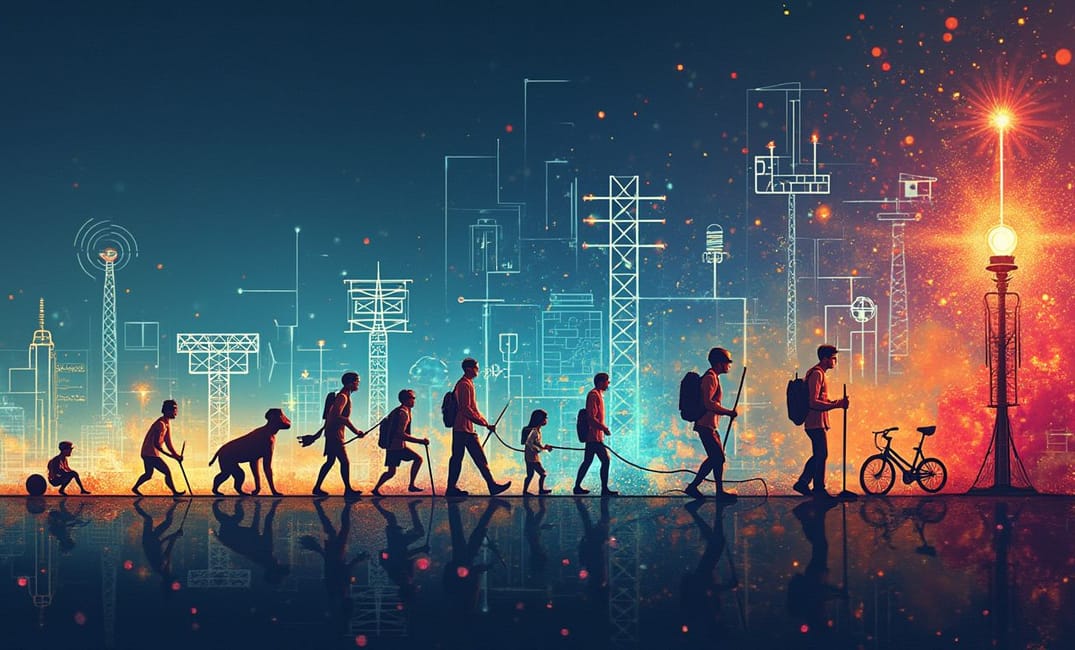Introduction: The Evolutionary Journey of Human Communication
Communication lies at the heart of human existence. It is the lifeline that connects individuals, societies, and civilizations across time and space. From the simplest gestures and primitive sounds, humanity has crafted myriad methods to convey thoughts, emotions, and information—each new method building upon the last. This complex architecture of communication has not only mirrored humanity's intellectual and cultural evolution but has also helped drive it. In this entry, we explore the remarkable story of human communication, tracing its development from ancient origins to the intricate networks of our digital era.
The Dawn of Communication: Gestures, Sounds, and Symbols
Primitive Signals and Early Language
- Gestures and Vocalizations: Early humans relied on gestures and vocalizations to express needs, emotions, and warnings. These rudimentary forms of communication laid the groundwork for more complex exchanges, driving social cohesion and cooperative survival.
- The Emergence of Proto-Language: As cognitive capacities expanded, so did the use of structured sounds. Proto-languages—a set of basic verbal cues—began to form, allowing for more effective sharing of information and abstract ideas, thus fostering community bonds and cultural development.
Symbolic Expression: The Birth of Writing
- Pictographs and Petroglyphs: The first attempts at visual communication emerged in the form of pictographs and petroglyphs, with early humans illustrating their experiences and environments. These symbols served both practical and spiritual purposes, providing insights into daily life and shared beliefs.
- The Invention of Writing Systems: The advent of writing systems like cuneiform in Mesopotamia and hieroglyphs in Egypt around 3400 BCE marks a pivotal moment. These systems enabled the recording of history, laws, and complex transactions, setting the stage for administrative structures and literate societies.
Storytelling and Oral Traditions: Weaving Cultural Tapestries
Transmission of Knowledge and Culture
- Oral Narratives: Before the widespread adoption of writing, oral storytelling was the primary means of preserving history, law, and culture. Narratives were passed down through generations, adapting and evolving, yet retaining the core essence of shared human experience.
- Epic Voyages and Myths: Epic tales such as the “Iliad” and “Beowulf” encapsulate the synergies between oral tradition and cultural identity, instilling societal values, preserving local history, and binding communities through shared lore.
Oral Traditions' Role in Education
- Mentorship and Learning by Story: Oral traditions also functioned as educational tools, where elders and mentors passed wisdom to the young, emphasizing moral lessons, social roles, and survival skills.
- Rituals and Community: Rituals and communal gatherings reinforced collective memory through reenactments and storytelling, ensuring cohesion and unity, while honing cognitive skills necessary for survival and prosperity.
The Printing Revolution: Catalyzing Global Transformation
The Birth of Print and Mass Dissemination
- The Gutenberg Press: Johannes Gutenberg's 15th-century invention of the movable-type printing press revolutionized information dissemination, democratizing access to written content and igniting transformations in education, religion, and science across Europe.
- Spread of Literacy and Critical Inquiry: The printing press facilitated the widespread spread of literacy and scholarly materials, accelerating the Renaissance and the Reformation by challenging established doctrines and prompting societal introspection and reform.
Literature and Enlightenment
- Publishing and Literature: The surge in print technology saw a proliferation of literature—fiction and nonfiction alike. The newfound capacity for mass production empowered authors and philosophers to influence public discourse and inspire intellectual revolutions.
- Enlightenment and Democratic Ideals: With access to a broader array of ideas and philosophies, the Enlightenment encouraged questioning of authority and fostered democratic ideals, paving the way for social and political upheavals.
The Electronic Epoch: Voice, Image, and Signal
Innovating Communication Technologies
- The Telegraph and Telephone: Pioneering breakthroughs like Samuel Morse's telegraph and Alexander Graham Bell’s telephone transformed communication's speed and reach, binding distant communities and enabling rapid information exchange.
- Radio and Television: The 20th century brought the golden age of radio and television, creating a new cultural landscape. From live broadcasts of historical events to entertainment, these mediums earned status as critical information conduits.
The Digital Revolution
- The Internet's Dawn: The late 20th century saw the inception of the internet, a network that revolutionized global communication. It became the backbone for virtually instantaneous exchanges across continents, bridging geographical and cultural divides.
- Mobile Communication: Mobile technology, driven by the proliferation of cell phones and smart devices, further revolutionized personal interactions by providing constant connectivity and access to information, fostering both convenience and dependency.
The Impact of Digital Communication: Challenges and Opportunities
Social Media and Virtual Interactions
- Interactive Platforms: Social media platforms have reshaped communication dynamics, enabling immediate sharing of thoughts, images, and news. They offer powerful tools for connection, though they equally present challenges in misinformation and digital etiquette.
- Digital Identity and Expression: The digital landscape offers newfound spaces for identity exploration and creative expression, allowing diverse voices to resonate globally. However, it also raises concerns over privacy and the authenticity of relationships formed online.
Ethical and Global Implications
- The Networked World: The interconnectedness brought by digital communication has immense implications for global unity. While it facilitates cross-cultural exchanges and understanding, it also risks homogenizing diverse cultures and perpetuating digital divides.
- Ethical Considerations: As digital communication becomes ever more embedded in daily life, ethical issues concerning data privacy, algorithmic bias, and digital governance call for critical societal and legislative responses to forge responsible, inclusive digital futures.
Conclusion: The Future of Human Communication
As human communication transforms, so does the very fabric of our societies and civilizations. The journey from primitive signals to a seamless digital expanse highlights humanity's continual pursuit of connection, understanding, and expression. The future will undoubtedly present new challenges and opportunities, as technologies and cultures evolve in tandem. Yet, within this flux, the fundamental human need to communicate—to share our stories, ideas, and experiences—remains steadfast, weaving the incessant threads of the human legacy through the tapestry of time.
"Across epochs, human communication reflects the eternal quest for connection and understanding—a dance of voices and visions shaping the kaleidoscope of shared experience, whispering the essence of what it is to be human."
SOCIAL MEDIA, EVOLUTION, GLOBAL IMPACT, STORYTELLING, PRIMITIVE SIGNALS, FUTURE OF COMMUNICATION, TECHNOLOGY, HUMAN COMMUNICATION, ETHICAL CONSIDERATIONS, DIGITAL ERA

